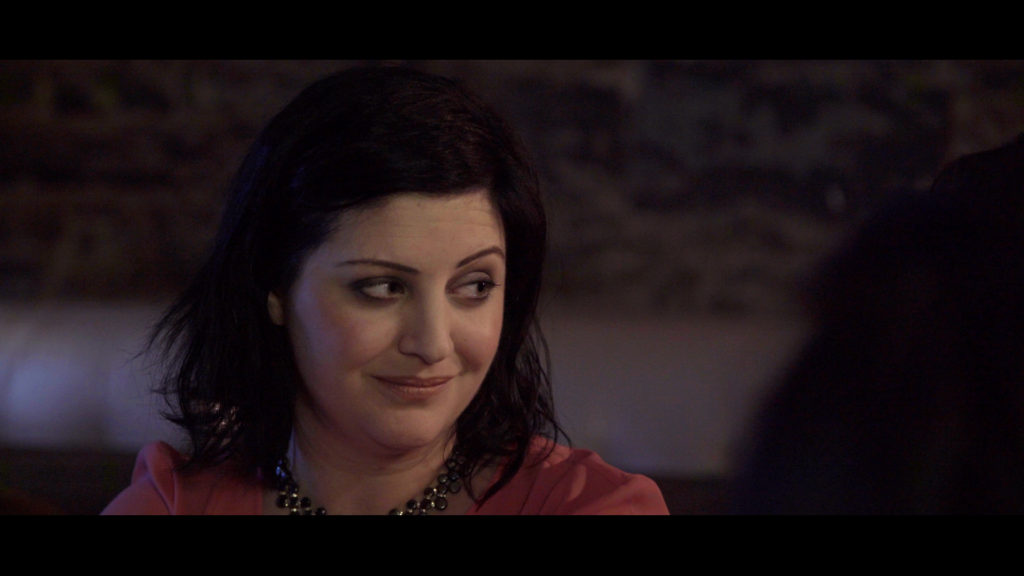Post Is In Session

Azin (Sherz Aletaha) throws a very skeptical look at her brother Behrouz (Arash Mokhtar)
Production is an exhilarating experience – every minute feels jam-packed with decisions to make, things to observe, issues to solve, and scenes to build. It’s almost like building a house, with a whole team coming together with a set of tools and trucks full of raw materials. Except at the end of the production, the house is only half-built.
OVERVIEW OF POST
So now what? In post, you take all the material you’ve shot (which was shot out of order and sometimes under extreme time pressure) and put together a coherent whole. This breaks down into phases:
Transcoding: First you have to transcode the footage from its original file format into something you can edit with. We shot on the Sony a7s Mark II, which produces 4K files in a compressed format (H.264). We transcoded the footage to 1080p, in ProRes (which is compressed in a different way that makes it more edit-friendly).
Syncing: Since the sound was recorded to a separate system, we had to synchronize the sound files to the transcoded video files.
Logging: As you’re doing this, you log your footage – seeing what you really have, and making notes on it (does the take work; are the performances good; are there continuity errors or sound problems). At the end of this step you know both the technical aspects of the footage, and you have a feeling for what takes you’ll use.
Rough Cut: The goal is produce a ‘loose’ version of the story. This is either a lot of fun or very depressing. As you start to really work with the material and cut it together, it’ll become evident what the holes or difficulties are. You may have to restructure or cut out bits of scenes.
Viewing: After the rough cut, you get feedback from a few people that you trust. Producers Daria Sommers, Ben Wolf, and Debarati Biswas weighed in on the cut and gave good notes on where scenes could be trimmed or expanded, how the piece felt overall, and what might be missing.
Second Cut: Then you go back in and make these changes, which inevitably trigger others. In our case, we’re trying to determine where to insert the documentary interviews we shot, whether we need more of them, and how the scenes play off each other. We just finished the second cut.
Viewing and Cutting: You repeat this process until the piece feels ‘tight’ – like if anything was added to or subtracted from it, it wouldn’t work as well. This is a very subjective thing, and sometimes it takes many months or years to get there – or just a few weeks. At the end of this step you have a ‘locked picture.’ At this point, except for last-minute emergency changes (except for the end credits), the picture shouldn’t change.
Sound Post: The sound designer takes over. The dialog is cleaned up, and effects, ambience, voice-over, and music are laid in. This is a great opportunity to be creative and ‘punch’ up the project.
Music: Starts while the picture cutting is winding down. A composer takes the locked picture and, working with notes from the director, sound designer, producer, and editor, writes and records the soundtrack.
VFX: This starts as the picture cut winds down. The locked picture is broken down into a set of visual effects cues (from boom removal all the way to CGI character building). Depending on the complexity of the work, it can take anywhere from one to many people, working for quite a while, to deliver the finished effects shots.
Sound Mix: Once the audio has been fixed and creative elements added, the audio is locked into place and mixed ‘down’ to whatever tracks are required for distribution.
Color/Conform: The locked picture, along with the visual effects shots and titles, is conformed (locked into place) and color corrected to ensure a consistent ‘look and feel’ to the film. In some cases, you have to go back to the original footage, and re-transcode everything you need (so if we wanted to finish the series in 4K, we’d have to transcode the footage to 4K ProRes rather than 1080). If the sound mix is done, the finished audio is also added.
Output: In our case, we just need a single high-quality QuickTime which we can then transcode to whatever file format YouTube, Vimeo, VHX, or our other distributors prefer.
When Does This Get Fun?
This is a technical overview of post, but it kind of obscures the fun part – watching Three Trembling Cities come to life, feeling the emotion that was hiding on the page come together in the finished scene, sculpting and polishing the work until its beauty shines through. We’ll cover this part of it in more detail in future posts.